TechByter E-mail Changes
Last week's TBWW e-mail came from Mail Chimp. That was unplanned but I had been evaluating the Mail Chimp service since September. This week's update also comes from Mail Chimp, but that's an intentional change. If you need to communicate regularly with customers, prospects, or subscribers, you might want to consider Mail Chimp.
Normally I record the podcast and prepare the newsletter on Friday and schedule the newsletter for transmission at 4am on Saturday. One copy comes to me, not to inflate the readership statistics, but so that I will know when the transmission occurred. Saturday is my day to sleep in so I'm rarely up before 6 but last Saturday I slept in until 9. When I checked for e-mail, I found no newsletter.
Usually that means I scheduled it for 4pm instead of 4am but not this time. It was sitting in the scheduler with a message that it would be sent 5 hours in the past so I deleted it and scheduled it again for immediate transmission. Then I started the scheduling process at Mail Chimp.
When the newsletter was ready to go via Mail Chimp, I checked Your Mailing List Provider and the message was still there. Again deleting it from the queue, I returned to Mail Chimp and scheduled an immediate transmission.
The service looks promising and if you have a newsletter that you'd like to distribute regularly, I recommend that you take a look at Mail Chimp.
Danger! Don't Click that Link!
When I deconstruct spam links on TechByter Worldwide they're usually just standard phishing spams or links to "Canadian" "pharmacies" that want to sell me "generic Viagra" but this week I encountered an unusual link—one that's truly dangerous—and I'd like to show you how it works.
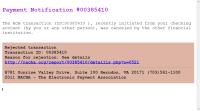 It started as what appeared to be a regular phishing exploit. The message told me that my ACH transaction had been "canceled by the other financial institution." NACHA is a legitimate organization that's a trade association for companies that provide electronic payment services. But NACHA appears not to send messages on its members' behalf and particularly not messages that say payments have been declined, canceled, or approved. The fact that the message was fraudulent was never in question.
It started as what appeared to be a regular phishing exploit. The message told me that my ACH transaction had been "canceled by the other financial institution." NACHA is a legitimate organization that's a trade association for companies that provide electronic payment services. But NACHA appears not to send messages on its members' behalf and particularly not messages that say payments have been declined, canceled, or approved. The fact that the message was fraudulent was never in question.
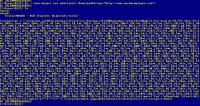 The message wanted to send me to a website so I fired up the Windows PowerShell and downloaded the default page from the site.
The message wanted to send me to a website so I fired up the Windows PowerShell and downloaded the default page from the site.
Had I followed the link, the site would have appeared to be "NACHA" and the browser banner would have said "ACH Transfer Rejected." But then what?
The screen of text may look like junk but notice the prevalence of "t" throughout the page. This is Javascript and "t" is defined as the number 2. The various functions (multiplying and dividing by t (2)) are all being evaluated. That's easy to replicate.
 So I broke the text at each comma and pasted the functions into an Excel spreadsheet and evaluated them.
So I broke the text at each comma and pasted the functions into an Excel spreadsheet and evaluated them.
Next I used the Excel vlookup function to match the resulting codes to the appropriate numbers and letters that the codes represent.
At the right is part of a table that shows the equivalent characters for decimal, binary, octal, and hex numbers.
 The vlookup table converted the apparent junk to readable text.
The vlookup table converted the apparent junk to readable text.
The primary thing I was looking for was easy to find. I wanted to know where this page would take me.
Each character is on a new line here. It would be much more readable if I would copy the text into a text editor and replace "(tab)" with tab characters and "(space)" with space characters.
Let's do that.
 And here's the result. All that code turns into a Javascript function that would open a new page.
And here's the result. All that code turns into a Javascript function that would open a new page.
What's on that page?
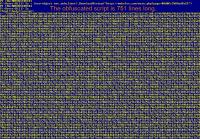 Hundreds of lines (751 to be exact) of obfuscated Javascript.
Hundreds of lines (751 to be exact) of obfuscated Javascript.
Each of the 2 characters is a hex code so 751 lines would equate to about 30,000 bytes of code.
What's going on here?
I didn't deconstruct this code but it's likely that it's an attempt to place malware on your computer. Because I keep my computer's security applications up to date, it's unlikely that this code would have damaged anything.
But I'm not willing to take a chance!
I good guideline to follow is this one: Never click any link in a message that refers to a financial transaction. If you believe that the message may be legitimate, go to the organization's website by typing the link address in to your browser.
ZOC It To Me!
"You should take a look at ZOC," a friend said. "It emulates just about every terminal you've ever heard of and it works on both my Windows and Mac machines." So I looked and I found that ZOC is a telnet/SSH/SSH2 client and terminal emulator that has tabbed sessions, configurable scrollback, scripting, and more. A lot more. I can see why anyone who needs access to a Unix shell account or just about any other type of system would like it.
ZOC is the terminal emulator that does everything everywhere. It offers telnet, SSH, SSH2, and serial console capabilities. It provides an extraordinarily wide range of terminal emulations. And it runs on Windows and Mac computers. If that's not enough, ZOC also includes X-, Y- and Z-modem file transfer protocols as well as Kermit and SCP.
At its most basic, a terminal emulator turns your smart desktop computer into a dumb terminal. Why would you want to do that? Maybe a little history is in order.
In the land before PCs, computers were very expensive. They lived in special rooms and, if you were lucky, you had on your desk a terminal that was connected to the mainframe (or minicomputer). When PCs appeared, they often sat beside terminals. And then somebody had the bright idea to write an application that made the PC looks like a dumb terminal so you got part of your desk back.
A dumb terminal is just that: A screen and keyboard that can communicate with a larger computer but has no built-in computing capability.
Mainframe and minicomputers still exist and if you connect to one you need a terminal emulator program. If you have a website, the hosting company probably provides secure shell (SSH) access. You might not be using this capability but you should consider it, and if you do, the only terminal emulator to consider is ZOC. Most websites run on Unix or Linux computers and SSH access provides capabilities that you can't obtain any other way.
The resurgence of client/server computing, which is actually 30-year-old technology has perhaps given terminal emulators appeal to a larger and more general market that includes home and small-office/home-office (SOHO) users.
ZOC is a favorite because it supports a huge range of terminal emulations. This includes the most popular emulations such as those used by Digital Equipment Corporation VT52, VT100, VT102, and VT220 terminals; standard ANSI terminals; TTY terminals; and Linux consoles. But it also provides emulations for Xterm; IBM TN3270 and TN5250; Sun CDE; Wyse 30, 50, and 60 models; ATT4410; the full Televideo 900-series, and even QNX V4 terminals. No matter what kind of system you're trying to connect to, ZOC probably has a terminal emulation that will work.
The tabbed-sessions feature means that it's easy to have multiple sessions open to the same or different mainframes and minicomputers using the same or different terminal emulations. ZOC maintains a history of typed commands and has a user-configurable scrollback function that allows you to review text that has scrolled off the screen.
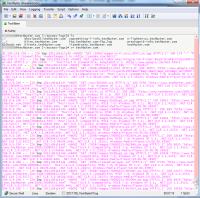 Can you read this? I can't make much sense out of it.
Can you read this? I can't make much sense out of it.
It's a TechByter Worldwide log file but the lines are so long that they've wrapped. With many telnet/SSH clients, this is what you'll see and there's no way to change it.
But with ZOC, all you have to do is drag the window so that it's wider.
 On the website this is too small to read because it's been reduced considerably. The live view on my screen is highly readable because now the lines don't wrap.
On the website this is too small to read because it's been reduced considerably. The live view on my screen is highly readable because now the lines don't wrap.
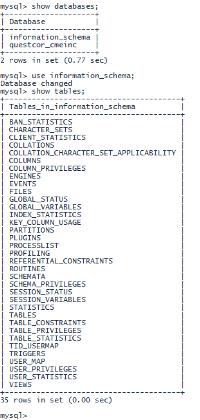 When you have SSH access to your Web server, you can communicate directly with the applications on the server.
When you have SSH access to your Web server, you can communicate directly with the applications on the server.
Here we're looking at some output from a MySQL database.
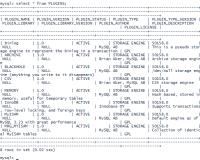 And here you see the same problem as with the log file. The output from the database is so long that each line of data actually is 3 lines on the screen.
And here you see the same problem as with the log file. The output from the database is so long that each line of data actually is 3 lines on the screen.
![]() Once again, you won't be able to read this because I've had to shrink it so much for the website. But on screen, the output is perfect and easy to read. Every telnet client should do this!
Once again, you won't be able to read this because I've had to shrink it so much for the website. But on screen, the output is perfect and easy to read. Every telnet client should do this!
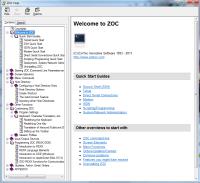 ZOC comes with a helpful and detailed help file that includes a Getting Started/Start Here section that covers the basics. Most telnet applications come with a scripting language that allows for automated log-ins as well as automated processes on the server. The language (REXX) has functions that watch for output from the server and respond. And you can assign scripts to buttons that you can add to the application's interface.
ZOC comes with a helpful and detailed help file that includes a Getting Started/Start Here section that covers the basics. Most telnet applications come with a scripting language that allows for automated log-ins as well as automated processes on the server. The language (REXX) has functions that watch for output from the server and respond. And you can assign scripts to buttons that you can add to the application's interface.
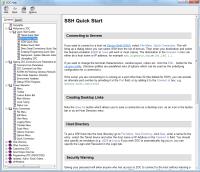 The help file is good when it comes to answering more complex questions, too.
The help file is good when it comes to answering more complex questions, too.

 If you speak telnet or SSH, you'll want ZOC.
If you speak telnet or SSH, you'll want ZOC.
Somehow ZOC had escaped my attention for several years but at last I found it (or was directed to it by a friend). I'm always delighted when a program that's clearly superior to all competitors shows up because then I can write about it. ZOC is more expensive that applications such as PuTTY (free) but less expensive than some other SSH clients that offer the user far fewer features.
For more information, visit the ZOC website.
Short Circuits
Indiana School District Replaces Books with Computers
Students in Munster, Indiana, will be seeing fewer books as the result of a change that puts computers in the hands (and book bags) of students starting in 5th grade. The change isn't being welcomed by everyone but it is the future.
According to the New York Times, the school district paid $1.1 million to buy computers for the district's 2600 students in grades 5 through 12 and the necessary infrastructure to support them.
The students seem to be accepting the change easily but it's reportedly left some of the teachers a bit stressed. And instead of the dog, it's now the server that gets blamed for missing homework.
The NY Times article quotes the head of the math department at Wilbur Wright Middle School, Pat Premetz: "The material we’re teaching is old but everything around it is brand-new." Premetz also said that while the change is overwhelming it's also the most exciting thing to happen in her 40 years of teaching.
School districts that transition to computers will still have to buy books for students, but the books will be electronic. In theory, the cost should be less because publishers won't need to pay for printing, storage, and shipping. The school district will need to store computers over the summer but 2600 computers will consume considerably less space than would be required for the 4, 5, or 6 books per student.
Thai Trouble Damages Disk Market
In an increasingly connected world, a big flood in Thailand can create problems for computer manufacturers in the United States. About one third of the disk drives used in personal computers are manufactured in Thailand.
The flood in August slowed production of drives in Thailand. Prices have increased. Manufacturers are having trouble obtaining sufficient supplies. Seagate, Western Digital, and Toshiba all have manufacturing facilities in Thailand.
The floods have closed 2 Western Digital plants and the company has tried to shift operations to a plant in Malaysia. Seagate's plants are still running but there's a problem obtaining components for the drives. Like Western Digital, Toshiba has suspended operations in Thailand.
The only larger manufacturer of disk drives is China.
Fortunately, computer manufacturers have relatively high levels of stock on hand so the situation isn't yet critical but it is ominous.
In Thailand, more than 300 people have died because of the floods and more than 8 million people have been forced out of their homes.
Yahoo Continues to Fade
These days it's a positive note for Yahoo when the company can report quarterly profits that aren't as bad as they were expected to be. The company seemed to be excited about the "not quite as bad as expected" news just as passengers on the Titanic were, no doubt, delighted to have a surplus of ice for their drinks.
Yahoo's sales were $1.2 billion for the quarter that ended in September but that dropped to slightly over $1 billion after deducting payments to partner websites. Overall, sales declined about 5% from the same period last year and profit declined more than 25% but the company was able to report small per-share earnings (23 cents per share).
Yahoo has started a new partnership with ABC News but the company's share of on-line advertising continues to drop as Google and Facebook see increases.
Chief Financial Officer Tim Morse (who is also temporarily the CEO) said that he's optimistic but didn't want to talk about a permanent replacement for Carol Bartz, the second CEO Yahoo has canned in about 12 months.


 The author's image: It's that photo over at the right. This explains why TechByter Worldwide was never on television, doesn't it?
The author's image: It's that photo over at the right. This explains why TechByter Worldwide was never on television, doesn't it?
